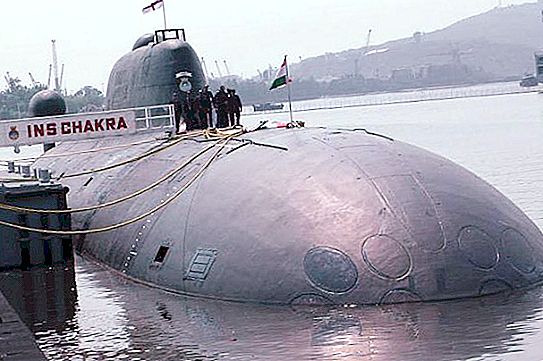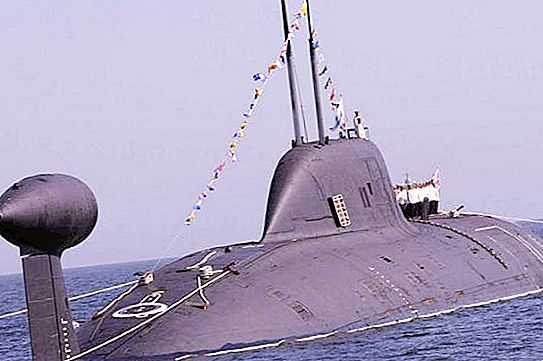K-152 “Nerpa” is a Russian-made nuclear submarine, also known as “Pike-B” or “971U”. The service of this ship in Russia was short: on November 8, 2008, during the tests, an accident occurred on it, and a year later it was withdrawn from the naval forces. In 2012, the boat was leased to India. Today we will get acquainted with the history of the ship K-152 "Nerpa".
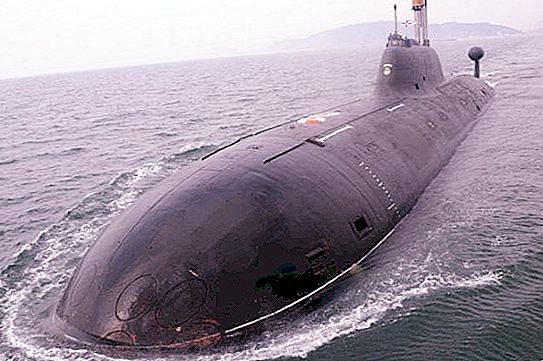
Construction
The submarine was laid at the end of 1991 at the Amur Shipyard. It was originally planned that the construction and testing of the vessel would take no more than five years. However, due to the curtailment of the nuclear shipbuilding program in the Far East, work was halted as soon as it began. Only in the fall of 1999, when the then Prime Minister of the Russian Federation V.V. Putin visited the plant, was a decision made on completion. It began only in 2004, after Minister of Defense Sergey Ivanov signed an agreement with the Indian Navy on the construction and leasing of two nuclear submarines.
On June 24, 2006 the ship was launched. It was originally planned to transfer it to the Indian side in August 2007, however, due to delays in the manufacturer, this date was constantly postponed. After the accident, the deadline was set for early 2011.
On June 11, 2008, tests began on the ship. In late October, the boat first went to sea, and on October 31 it plunged under water.
The accident on the K-152 "Nerpa"
On November 8, 2008, the Nerpa left the Zvezda factory and went to the combat training area for the next stage of testing - torpedo firing. On this day on the decks of the second compartment of the boat there was an unplanned actuation of the fire extinguishing system. On average, the concentration of freon in the compartment was 300 times higher than the permissible value. As a result of the accident, 20 people, 17 of whom were civilian observers, died. Another 21 people suffered from suffocation, frostbite and burns to the respiratory tract. Many also sought medical help after a few days. In total, there were 208 people on the boat that day, of which 81 were military personnel, and the rest were civilians (factory specialists, delivery crew, and others).
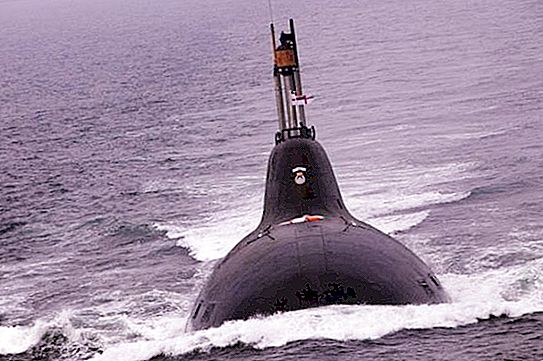
During the tests, in addition to the crew on board, there was a commission commission, equal in number of people to two more crews, and a less numerous state commission. This number of teams was due to the fact that the joint work of many devices and systems is set up directly in the process of testing. Regarding whether there were representatives of the customer and the designer on board, there is no information.
According to an official statement, the accident did not affect the power units. The ship independently traveled under its own power to a temporary base, and all the victims were brought ashore by the anti-submarine ship Admiral Tributs.
Investigation
The prosecutor's office opened a criminal case under the article “Violation of the rules for the operation and driving of a warship, which resulted in the death of more than two persons." There were lively discussions about the alleged causes of the accident. Initially, a computer failure and an illiterate test organization were called the probable cause. Investigators later found that the fire extinguishing system was unauthorized by one of the sailors, Dmitry Grobov. A criminal case was instituted against him under the article “Causing death by negligence”.
Despite the fact that Grobov pleaded guilty, his colleagues do not believe that he could have made such a mistake. Captain of the second rank Igor Chefonov also expressed his dissatisfaction with this state of affairs, saying that according to the charter, sailors should not be left unattended.

In November 2008, data appeared according to which Grobov was in a state of shock and gave slurred testimonies. On November 21, the media reported that a psychological examination would be conducted on the sailor. At the same time, Sergei Stolnikov, a member of the delivery team, said in an interview that the cause of the disaster was a flaw in the console of general ship systems.
It remained unclear why, after the fire system was triggered, freon reserves for three compartments fell into one, and why, despite the fact that the boat was fully equipped with breathing apparatus, so many people died.
New facts
On December 4, 2008, information appeared that instead of low-toxic tetrafluorodibromoethane poisonous tetrachlorethylene was pumped into the fire extinguishing system. The mixture was supplied by the St. Petersburg company ServiceTorgTehnika, with which the Amur Shipyard worked for the first time. Before refueling, a second check of the freon was carried out, in which the laboratory only confirmed that it was freon.
On January 22, 2009, Grobov was recognized as responsible and continued to be considered as the main culprit of the tragedy. On February 10, information appeared that the manufacturer of the K-152 Nerpa submarine intends to sue the supplier of freon. After that, the commission that conducted the investigation assigned the stamp “Top Secret” to the final act.
Court
In March 2011, the Pacific Fleet Military Prosecutor's Office referred the case to the Pacific Fleet military court. The charges were brought against the hold engineer Dmitry Grobov and the commander of the vessel, captain of the first rank Dmitry Lavrentiev.
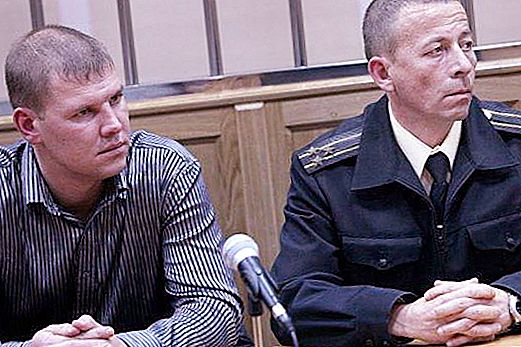
On April 25, a preliminary hearing was held at which the court decided to consider the case with the jury. June 22 was the first meeting, which was held behind closed doors. On July 5, at the second meeting, Dmitry Grobov refused the testimony that he had given earlier, and declared his innocence. He called the previous statements self-incrimination given under "pressure from law enforcement agencies."
From September 2011 to September 2013, the jury acquitted the accused three times and received an appeal from prosecutors twice. For the third time, the Military Collegium decided: “The acquittal shall be upheld, and the complaint dismissed.
Toxicological expertise
According to the results of chemical analysis, it was found that 64.4% of the mixture of freon was tetrachlorethylene, which should not be used for fire fighting. A fire extinguishing concentration of freon is not fatal to humans. The worst thing that can happen in contact with him is loss of consciousness. Therefore, even if the sailor had really activated the fire extinguishing system on purpose, this would not have led to deaths.
The submarine K-152 Nerpa system was fueled by a fake extinguisher. When it worked, due to the difference in the physical parameters of the poisonous freon from the normal one, three portions of the chemical automatically went into one compartment. The compartment was filled with saturated steam of the mixture and a droplet-liquid phase, part of which was collected on the walls and flowed down. Pure freon should be sprayed as an aerosol. With increasing temperature, it evaporates and is already in gaseous form in contact with the foci of combustion. By interfering with the process at the chemical level, the freon acts as a moderator, anticatalyst and combustion inhibitor. Moreover, contrary to popular belief, it does not displace or bind oxygen. In a burning room, oxygen can only be consumed to maintain fire. If the fire system is activated without fire, the amount of oxygen in the room does not change.
Recovery
The restoration of the K-152 Nerpa boat cost the Russian Navy nearly two billion rubles. Presumably, such costs were associated with the fact that part of the equipment was destroyed by the action of tetrachlorethylene, which is an active solvent. The fake extinguisher has been replaced with a normal one, and the fire extinguishing system has been modernized. The return team, with more than 200 people, was retrained.
Retest
Due to the difficulties in forming the final team, the start of the retest was delayed. They began on July 10 and continued until December 25, 2009. On December 28, a representative of the Pacific Fleet announced the successful completion of tests and the entry of the 971U Schuka-B or Nerpa submarine into the Russian Navy.
India Transfer
Throughout the construction of the boat, statements about the prospect of its transfer to the Indian Navy have been repeatedly voiced and refuted. After the accident, information appeared that the vessel would not be sold or leased, but would join the ranks of the Russian fleet. However, the Indians had big plans for this boat, in particular, regarding the training of the crew of the vessel INS Arihant - the first Indian nuclear submarine. In 2009, the press again talked about the prospects of leasing.
In February 2010, a crew from India arrived at the port of registry of the submarine for an internship. On June 1, Mikhail Dmitriev, the head of the military cooperation service, announced that the crew had completed the training and that the matter was nearing the finish line. The final transfer of K-152 Nerpa to India was scheduled for October 2010.
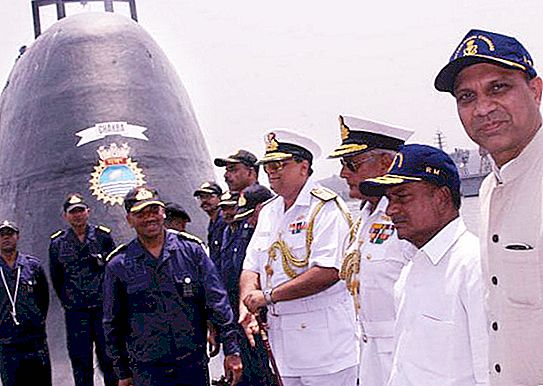
Only on October 4, 2011 did the Russian-Indian commission agree on the completion of the acceptance tests. They were supposed to begin on October 30 and last 15 days. A week was allotted to eliminate the comments.
According to Izvestia, Indian representatives of the intergovernmental commission would like to refuse this contract, but plunged into it so much that it was no longer possible. They were not satisfied with the reliability of the ship and its armament, as well as the inconsistency with Soviet quality standards that have become famous throughout the world.
After repeatedly transferring the lease of K-152 Nerpa on December 30, 2011, a contract was nevertheless signed.
Ceremony
On January 23, 2012, a ceremony was held to transfer the Russian Guards nuclear submarine K-152 to the Indian naval forces. The ceremony was organized on the territory of the shipyard in the city of Big Stone. Ajay Malhotra, the Ambassador of India to the Russian Federation, and Admiral Konstantin Sidenko, commander of the Eastern Military District, took part in it. The Indian side also invited Captain Lavrentiev, the commander of the ship during the 2008 tragedy, to the ceremony. The total transaction value amounted to $ 900 million.

